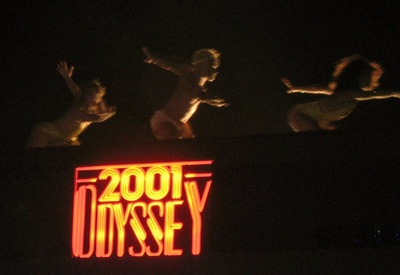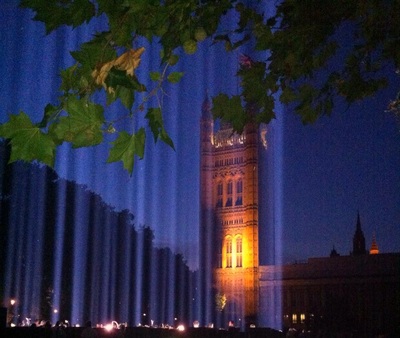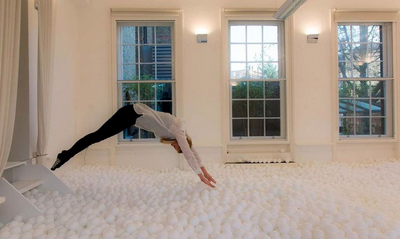| London is a cultural hotbed. Homegrown talent thrives here, and established international talent is magnetized to a city which greets creative expression with open arms. With enough new things to see and do to fill a magazine on a weekly basis, London is ever-evolving, keeping its citizens on their toes. Its pop-up events and exhibitions are made appealing by their temporality and Time Out's encouragements to 'Get there whilst it’s hot’, induce the F.O.M.O* effect with expertise... |
In a world where all things virtual play such an important role in everyday activity, does the popularity of cities like London, which demand to be experienced, prove that physical engagement, stimulation and interaction take precedence? And what role does art play in bringing the experiential to the forefront?
Three years spent pouring over books in my quest to understand the social history of art, which was as much to do with philosophy and cultural studies as it was art history in the traditional sense, led me to an appreciation of a particular kind of art. It’s the kind that inspires me to undertake a relentless pilgrimage to various sites across London before the last grain of sand trickles through London’s weekend hourglass.
It’s often that which people argue ‘isn’t art’. And they’d be right…if it wasn’t for the emergence of Performance Art in the 1960s, which erupted, center stage, to the script of Conceptualism.
If it was still perceived to be true that the very materiality of art must be tangible, then experiential art as we see today might never have reached our shores. In 2014, however, thousands of people, including myself, flocked to see art which involves little more than time, space, or people....
The current trend in relational experiences can be seen from art to cinema and theatre, with the likes of Secret Cinema and more recently the Secret Theatre Company - in particular ‘A Series of Increasingly Impossible Acts’ proving popular.
It’s no coincidence that the hospitality sector too has been increasingly leaning towards an experience or performance offering, for the ideas that inspire art so too inspire the greater world. From speak-easy inspired bars, to dining experiences offered by the likes of the Mall Tavern, where desert is nothing short of a masterpiece, the interactive experience is sought after.
But why?
Does the narcissist in us send us flying like a moth to bright light at the chance of the perfect photo opportunity? Is the chance of being immersed in a shared experience too much to pass up? Are these experiences a form of escapism from mundane routines? Or are we eagerly chasing trends…or simply being tourists?
For me all of the above is true. I want to be involved, to be in the moment, to try something new, and to make the most of London’s cultural dynamism.
Author: Sarah Moor
Three years spent pouring over books in my quest to understand the social history of art, which was as much to do with philosophy and cultural studies as it was art history in the traditional sense, led me to an appreciation of a particular kind of art. It’s the kind that inspires me to undertake a relentless pilgrimage to various sites across London before the last grain of sand trickles through London’s weekend hourglass.
It’s often that which people argue ‘isn’t art’. And they’d be right…if it wasn’t for the emergence of Performance Art in the 1960s, which erupted, center stage, to the script of Conceptualism.
If it was still perceived to be true that the very materiality of art must be tangible, then experiential art as we see today might never have reached our shores. In 2014, however, thousands of people, including myself, flocked to see art which involves little more than time, space, or people....
- More than 110,000 people queued to be in a room with Marina Abramovic: to stand with her in silence, to sit and stare at a wall with a pair of headphones playing nothing but silence, and to share her ‘512 Hours’.
- Crowds gathered on summer evenings to observe light beams from 49 search lights in Victoria Gardens. ‘Spektra’, the interactive installation, was nothing short of a spectacle, illuminating the side of the Houses of Parliament and creating a supernatural ambience.
- The Hayward Gallery saw grown adults running around a room full of white balloons at Martin Creed’s retrospective, statically charged.**
The current trend in relational experiences can be seen from art to cinema and theatre, with the likes of Secret Cinema and more recently the Secret Theatre Company - in particular ‘A Series of Increasingly Impossible Acts’ proving popular.
It’s no coincidence that the hospitality sector too has been increasingly leaning towards an experience or performance offering, for the ideas that inspire art so too inspire the greater world. From speak-easy inspired bars, to dining experiences offered by the likes of the Mall Tavern, where desert is nothing short of a masterpiece, the interactive experience is sought after.
But why?
Does the narcissist in us send us flying like a moth to bright light at the chance of the perfect photo opportunity? Is the chance of being immersed in a shared experience too much to pass up? Are these experiences a form of escapism from mundane routines? Or are we eagerly chasing trends…or simply being tourists?
For me all of the above is true. I want to be involved, to be in the moment, to try something new, and to make the most of London’s cultural dynamism.
Author: Sarah Moor
*Fear Of Missing Out
**The success of the latter has recently inspired an adult size ball pool by creative agency Pearlfisher. Playtimes are of course already sold out.
**The success of the latter has recently inspired an adult size ball pool by creative agency Pearlfisher. Playtimes are of course already sold out.








 RSS Feed
RSS Feed
